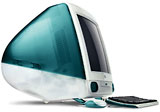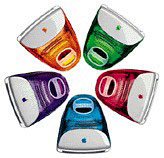- 2005.12.20
I may be only 17 years old, but I remember a time when computers
were tools. You didn't buy a computer because of what it looked like;
you bought a computer because of what it did.
These days it seem like more and more people buy computer not
because of what they can do but because of what they look like.
Enter the iMac
This change seems to have started in May of 1998 when Apple
introduced the iMac.
The iMac was supposed to be "the Internet age computer for the rest of
us".
 Everyone was raving about how powerful
it was, and they were also raving about how cool it looked. Everyone
loved the futuristic looking Bondi blue case.
Everyone was raving about how powerful
it was, and they were also raving about how cool it looked. Everyone
loved the futuristic looking Bondi blue case.
The iMac came in one configuration - 233 MHz G3, 32 MB RAM, 4 GB
hard drive, 24x CD-ROM - so it would be easy for consumers to buy one
without making a million decisions.
 In January of 1999, Apple introduced
the Rev. C iMac, the
one that came in blueberry, grape, tangerine, lime, and strawberry.
In January of 1999, Apple introduced
the Rev. C iMac, the
one that came in blueberry, grape, tangerine, lime, and strawberry.
Steve Jobs thought that people didn't care about megabytes,
megahertz, or gigabytes - customers wanted to trust the computer
company to sell them a really great computer. The only question they
should have to answer is, "What's your favorite color?"
The iMac was popping up everywhere. It was on busses and billboards,
in TV and magazine ads, on radio ads, and all over the Internet.
It was everywhere. No one could get enough of it.
About Face
But Steve Jobs was wrong about one thing: People do care about
megabytes, megahertz, and gigabytes.
In the summer of 1999, Apple decided it was time to get rid of their
easy-to-buy single configuration iMac and introduced the new iMac.
From this point on, it would no longer be as easy for a newbie to
buy an iMac. He or she would have to choose from different speeds, not
just colors. These were the new models:
iMac
(blueberry, $999)
- 350 MHz G3, 64 MB RAM, 6 GB hard drive, slot loading CD-ROM
drive
iMac DV
(blueberry, grape, tangerine, line, strawberry, $1,299)
- 400 MHz G3, 64 MB RAM, 10 GB hard drive, slot loading DVD-ROM
drive
- 400 MHz G3, 128 MB RAM, 13 GB hard drive, slot loading DVD-ROM
drive
The iMac kept selling in record numbers, and then Apple went a
little crazy in the summer of 2000 with the next set of models. Now if
you wanted a certain color, you might have to spend a certain amount of
money:
iMac (indigo,
$799)
- 350 MHz PowerPC G3
- 64 MB RAM
- 7 GB hard drive
- slot loading CD-ROM drive
iMac DV (indigo,
ruby, $999)
- 400 MHz PowerPC G3
- 64 MB RAM
- 10 GB hard drive
- slot loading CD-ROM drive
iMac DV+ (indigo,
ruby, sage, $1,299)
- 450 MHz PowerPC G3
- 64 MB RAM
- 20 GB hard drive
- slot loading DVD-ROM drive
iMac DV SE
(graphite, snow, $1,499)
- 500 MHz PowerPC G3 Processor
- 128 MB RAM
- 30 GB hard drive
- slot loading DVD-ROM drive
It was out of control. There were just too many models and colors
and price points - eight different iMacs in all. These models (and the
colors ruby and sage) only lasted a few months before iMacs with the
CD-RW drives entered the picture.
 Anyone remember the Blue Dalmatian and Flower
Power models? I don't know what Apple was thinking with those two
color schemes, but for some reason they lasted longer than the ruby and
sage. Can someone explain that one to me?
Anyone remember the Blue Dalmatian and Flower
Power models? I don't know what Apple was thinking with those two
color schemes, but for some reason they lasted longer than the ruby and
sage. Can someone explain that one to me?
Enter the iPod
Then in October of 2001, Apple introduced the iPod. At first it was a Mac-only
accessory, but when Apple developed software so it could run on
Windows, it started selling in record numbers. Now it's the #1 selling
MP3 player in the market.
People love the way it looks and the way it works, and back then
there was only one model to choose from.
 As for today's
computers, I don't know if people are buying them because of the way
they work or the way they look.
As for today's
computers, I don't know if people are buying them because of the way
they work or the way they look.
Apple has a big presence in the world of fashion right now -
everyone wants an iPod, and everyone is trying to make their computers
look like Apple's computers.
Why did computers become such a big fashion statement?
When you're using your computer, are you really thinking about how
much you like the way it looks?


 Everyone was raving about how powerful
it was, and they were also raving about how cool it looked. Everyone
loved the futuristic looking Bondi blue case.
Everyone was raving about how powerful
it was, and they were also raving about how cool it looked. Everyone
loved the futuristic looking Bondi blue case. In January of 1999, Apple introduced
In January of 1999, Apple introduced
 Anyone remember the
Anyone remember the  As for today's
computers, I don't know if people are buying them because of the way
they work or the way they look.
As for today's
computers, I don't know if people are buying them because of the way
they work or the way they look.
